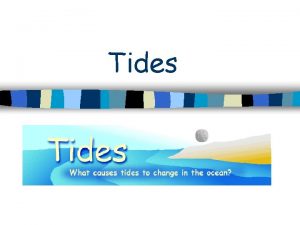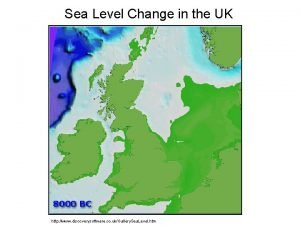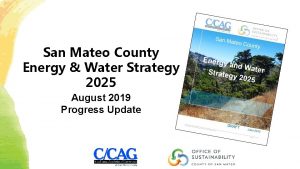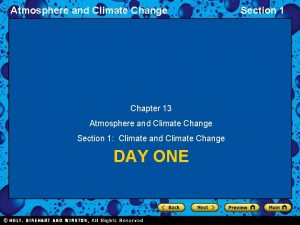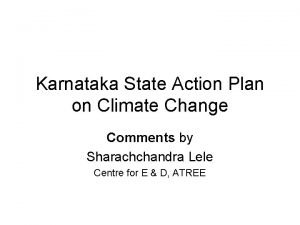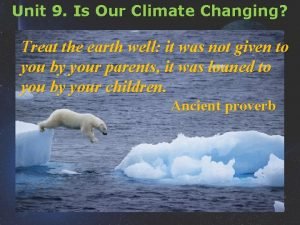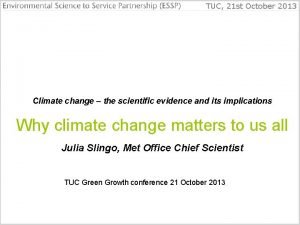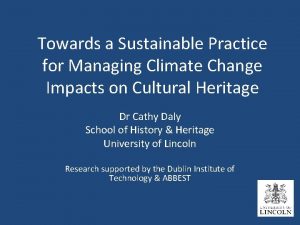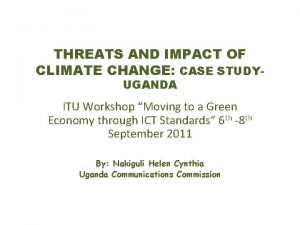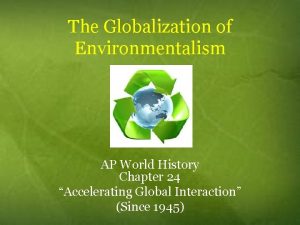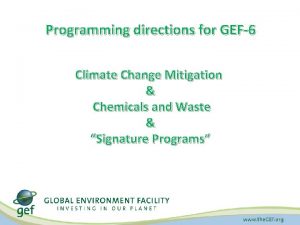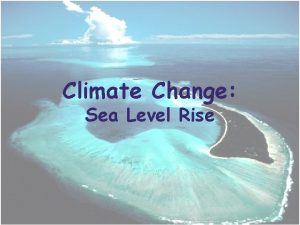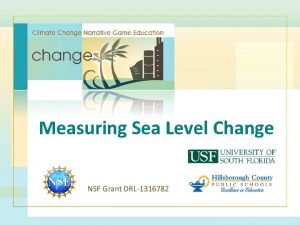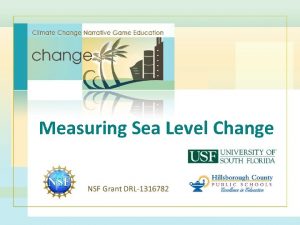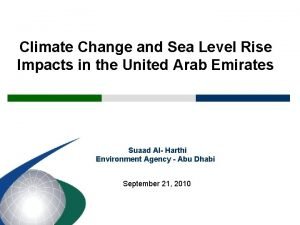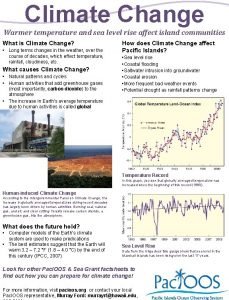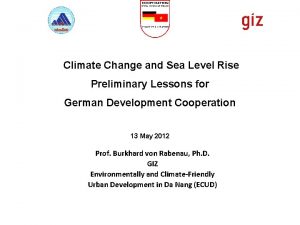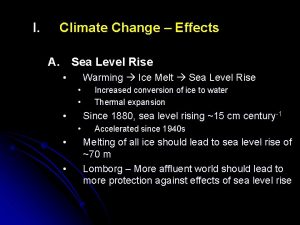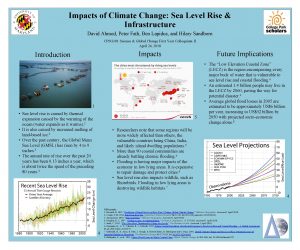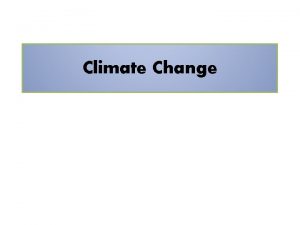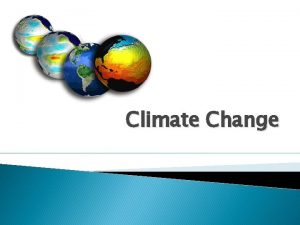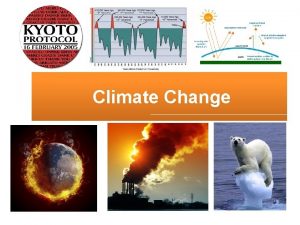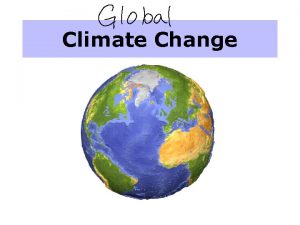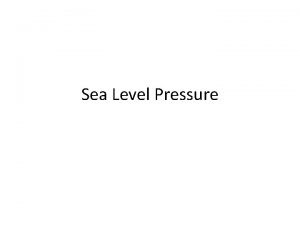Sea Level Rise Climate Change and the Human



























- Slides: 27

Sea Level Rise, Climate Change, and the Human Impacts on the American Crocodile in the Everglades National Park Kayla Berger, Rachel Case, Chase Garrison, Austin Greenhill, Angela Kennedy, Lena Midgette, Alissa Ralston, Fallon Woolford & Alexa Zwicker

Introduction ● Everglades National Park established in 1947 ○ Shrunk by over half (3 million to 1. 5 million acres) ● The American Crocodile: ○ Endangered in 1975 (IUCN Red. List) ○ Threatened in 2007 ○ 2, 000 in wild (nationalgeographic. com) ● Joe Bay: ○ Closed in 1980 ○ Re-opened 2016 ● Comprehensive Everglades Restoration Program: ○ Restoring natural water flow and habitat ○ Other anthropogenic threats not considered.

The System ● Joe Bay The Stakeholders ● Farmers, citizens, conservation biologists, fishermen, local government officials, and tourists The Challenge ● Addressing the anthropogenic related threats to the Everglades National Park Goal Statement: Finding balance between socio-economic activity, human well-being, and the preservation of habitat, biodiversity, and “safeguarding” the Everglades National Park ecosystems

Hazards Climate Change ● CO 2 ○ Absorbed 28% for 200 years (Bennett, 2018) ○ Dropped from 8. 2 to 8. 1 p. H (Bennett, 2018) ● Temperature ○ 2 Degree Celsius increase since 1900 (EPA, 2016) ○ Low-High risk scenarios: 2. 3 -5 degrees Celsius increase by 2100 (EPA, 2016) ● Hurricanes ○ Strength has intensified in the last 5 years (Rahmstorf, 2018) ○ Range expected to expand (Rahmstorf, 2018) ● Droughts: ○ Water level will decrease between 5 -114 cm (Nungesser, 2015) ○ Expected to increase average salinity (Nungesser, 2015)

Hazards Sea Level Rise: ● Rising at a rate of 2. 8 -3. 1 mm per year globally ○ Projected to rise 1 -2 m by 2100 (Allison et al. , 2009) ● Inundation ○ ○ Salinity+lack of freshwater flow Erosion Could accelerate ecosystem losses Loss in shoreline

Hazards ● Urban Development ○ Levees: ■ 2, 800 miles of levees, canals and berms and 1, 200 pumping stations ■ Displaced slough vegetation ○ Eutrophication: ■ Phosphates contribute to accelerated vegetation growth Image from the Everglades Foundation. ○ Population Growth ■ Current: ● 20. 9 million people, 9. 4 million housing units with 7. 3 million being households (United States Census Bureau, 2017) ■ Future: ● 25 million by 2030 and 32 million by 2050 ● Florida receives the 3 rd most immigrants with a projected 1. 9 million additional immigrants by 2025 (NPG)

Hazards ● Invasive Species ○ Over 500 fish and wildlife nonnative species in Florida ■ Displace natives ■ Threaten ecosystem balance ■ Outcompete natives for food and space ■ Have lack of predators or natural diseases ■ Alter habitat structure ■ Force competition thus leading to reduction of natives

Vulnerabilities Florida Bay Ecosystem ● Climate Change ○ Water temps ■ Widespread extinction ■ Higher rates of migration ○ Sea Level Rise ■ Habitat and Biodiversity loss ■ SLR on US coastline: 25 -30% higher than global average ○ Urban Development ■ Water Salinity ○ Invasive Species ■ Problematic Species ● Burmese Python, Argentine Tegu ● Australian Pine, Pepper Tree, Cattails

Vulnerabilities Mangroves ● Climate Change ○ Carbon dioxide and Temperature ● Dying off coral reefs are expected to have an impact on mangroves ○ Droughts ● Expected to cause a decrease in average water level and create unfavorable conditions for mangroves ● Sea Level Rise ○ Depleting at a rate of 0. 7 -2. 1% ○ (+15 ppt) and - 8 cm inundation: collapsed peat (Chambers et al. , 2013)

Vulnerabilities Mangroves Cont. . . ● Urban Development ○ Habitat loss from coastal urbanization ○ Infringement ○ Diking, impounding, and flooding activities affect salinity promoting exotic vegetation growth

Vulnerabilities American Crocodile ○ Climate Change ■ Temperature affects sex of crocodiles ■ Can have disastrous effects on the level of reproduction ○ Sea Level Rise ■ Habitat loss: ● ⅔ of nesting sites along sandy shores ■ Juveniles most sensitive to salinity ■ No mangroves=no protection

Vulnerabilities American Crocodile Cont. . . ○ Urban Development ■ Roads, Neighborhoods ■ Lack of Nesting sites ■ Eutrophicationstimulation of highbiomass algal overgrowth

Conceptual Model Vulnerabilities

Climate Change Foresight and Effects on Everglades and American Crocodiles ● Increasing Regional Sea Surface Temperature Scenarios ○ Scenarios regarding sea surface temperature (SST) based on Donner (2009) ■ Commit scenario: ending future CO 2 emissions to keep atmospheric CO 2 concentrations under 500 ppm, which projects an average regional SST increase of 0. 4 -0. 6 o. C by 2100 ■ Mitigation scenario: reduce CO 2 emissions, CO 2 concentrations between 500700 ppm by 2100, projected 1. 1 -1. 5 o. C increase in average regional SST ■ Business-as-usual approach: rate of CO 2 emissions remain at current levels, atmospheric CO 2 concentrations at >700 ppm by 2100, 1. 9 -2. 4 o. C average regional increase in SST.

Climate Change Foresight and Effects on Everglades and American Crocodiles ● Ocean Acidification Scenarios based on IPCC AR 5 (2015) ○ Potential decreases in ocean p. H based on CO 2 emissions ■ RCP 2. 6 (commit): CO 2 concentrations below 500 ppm, 0. 06 to 0. 07 p. H decrease (15 to 17% increase in acidity) ■ RCP 6. 0 (mitigation): CO 2 concentrations between 500 -700 ppm, 0. 20 to 0. 21 p. H decrease (58 to 62%) ■ RCP 8. 5 (business-as-usual): CO 2 concentrations >700 ppm, 0. 30 to 0. 32 p. H decrease(100% to 109%)

Climate Change Foresight and Impacts on Everglades and American Crocodiles ● Impacts of Increasing SST ○ Marine species ■ disruption of food chains, loss of coastal habitats/nursery locations ○ American Crocodile: ■ likely able to adapt and migrate to new habitats, potential increase in geographic range ■ primary threats are loss of nesting locations from coastal development and more males than females being born ○ Increasing hurricane/storm intensities ● Impacts of Ocean Acidification ○ Ocean Acidification & Increasing SST = coral bleaching ■ First line of defense for mangroves and coastal areas ■ Leaves potential crocodile habitats and nesting areas vulnerable to increasingly intense hurricanes/storms

Climate Change Foresight and Impacts on Everglades and American Crocodiles Perez et al. (2017)

Sea Level Rise Foresight & Impacts on the Crocodile ● High Risk Scenario ○ ○ UCS determined sea level rise of 2. 0 m by 2100 Assumes rising CO 2 emissions & rapid ice sheet loss Complete inundation of Everglades Park Crocodile habitat/nests at high risk: high rate of nest failure/year ■ Same proximity as humans ■ Intensified storm surges due to wetland loss ■ Inundation by sea water inhibits nest & juvenile success ○ Fish density decrease due to intrusion of seawater leads to potential food source challenge for juveniles ○ Ability to migrate & adapt dependent on accelerated population growth & stability between 2020 -2035 (Caldas et al. , 2017)(earthtime. org)(Brandt et al. , 2004)

Sea Level Rise Foresight & Impacts on the Crocodile (USGS, 2018)

Sea Level Rise Foresight & Impacts on the Crocodile ● Intermediate Risk Scenario ○ ○ ○ UCS determined sea level rise of 1. 2 m by 2100 Assumes rising CO 2 emissions & moderate ice sheet loss Significant inundation of Everglades Park, 20 -25% of Everglades not inundated Crocodile habitat/nests at high risk: high rate of nest failure/year ■ Close proximity to humans ■ Intensified storm surges due to wetland loss ■ Inundation by sea water inhibits nest & juvenile success Fish density decrease due to intrusion of seawater leads to potential food source challenge for juveniles Ability to migrate & adapt dependent on accelerated population growth & stability between 2020 -2050 (Caldas et al. , 2017)(earthtime. org)(Brandt et al. , 2004)

Sea Level Rise Foresight & Impacts on the Crocodile ● Low Risk Scenario ○ UCS determined sea level rise of 0. 5 m by 2100 ○ Assumes rising CO 2 emissions & minimal influence from ice sheet loss ○ Inundation of Southern Everglades Park, 40 -50% of Everglades not inundated ○ Crocodile habitat/nests at high risk: moderate of nest failure/year ■ Near proximity to humans ■ Intensified storm surges due to wetland loss ■ Inundation by sea water inhibits nest & juvenile success ○ Fish density decrease due to intrusion of seawater leads to potential food source challenge for juveniles ○ Ability to migrate & adapt dependent on accelerated population growth & stability between 2020 -2080 (Caldas et al. , 2017)(earthtime. org)(Brandt et al. , 2004)

High Risk Scenario for the Future of Humans and the Everglades Population 2017: 20. 98 million (Census Bureau, 2017) ● Population could reach 36 million by 2060 (UCF, 2007) Under the Scenario SLR 2. 1 m ● FL Keys, Naples, E. N. P-Inundated, Miami-New keys (Earth. Time. org, 2018) ● Massive migrations to Central FL around Lake Okeechobee ● Rapid development leads to high Eutrophication ● Little space and fresh water left for American crocodile ● Human loss: Protection, Physiological, Economic What if… Estimates do not consider mass migrations from Neighboring Countries IPCC predicts developing countries are experiencing the harshest effects of Climate change (UCF, 2007)

Intermediate Risk Scenario for the Future of Humans and the Everglades Still using the same estimates for population growth Under the senario SLR 1. 2 m ● FL Keys, and about 75% of E. N. P. -induated, significant impacts for Miami (Earth. Time. org) ● Less population per square mile for migration ● Tighter policies/better utilization of space ● Progress toward historic flow ● More time with the American Crocodile ● Migration toward Conservation Wetlands (Census Bureau, 2010)

Low Risk Scenario for the Future of Humans and the Everglades Still using the same estimates for population growth Under the SLR scenario 0. 5 m ● ● ● Could inundate the keys (Earth. Time. org) Smaller density of migration Same development plans to pack tight Tight regulations on runoff, water control Restore historic flow Allows for more balance

Decision-Making Stakeholders Regulatory & Executive ● ● Florida Fish and Wildlife Conservation commission US Environmental Protection Agency Local Governments Everglades National Park Employees Beneficiaries of Ecosystem Services ● Local Farmers ● Tourism ● Commercial fishermen Land Use ● Private landowners ● Local Farmers

Options 1. Make steps to federally protect Lake Okeechobee. Current restoration plan & preserving Lake Okeechobee ● Stacking houses 2. Ensure limited access Joe Bay ● Community outreach ● Educating the public on the importance of the American Crocodile. 3. Further research should be developed on the spatial and temporal patterns of nesting habitat loss of the American Crocodile in response to sea level rise, to establish a management plan for migration.

Recommendations ● Ensure limited access in Joe Bay ■ With Joe Bay closed for 36 years, and the lifespan of the American Crocodile reaching 70 years, younger populations are unaccustomed to human presence. ■ Decrease in the disturbance of nests leads to an increase in survival rate of juveniles. ■ Increasing survival rate facilitates species migration if habitat loss increases. ■ Will increase fishing activity, decreasing fish populations as a crocodile food source ■ Most Viable Population: 3, 000 -5, 000 individuals to sustain population ○ Community outreach will allow Florida Bay locals to understand the issues the area is facing in relation to sea level rise, development, the American Crocodile, and build participation in conservation efforts ● Further research should be developed on the spatial and temporal patterns of nesting habitat loss of the American Crocodile in response to sea level rise, to establish a management plan for migration.
 Climate change 2014 mitigation of climate change
Climate change 2014 mitigation of climate change The difference between spring tides and neap tides
The difference between spring tides and neap tides Sea level rise map uk
Sea level rise map uk Sea level rise
Sea level rise Tricky dick: the rise and fall and rise of richard m. nixon
Tricky dick: the rise and fall and rise of richard m. nixon Sheep become lions
Sheep become lions Raise and rise again until lambs become lions
Raise and rise again until lambs become lions A union b example
A union b example Conclusion of climate change
Conclusion of climate change Yellow sea and east china sea
Yellow sea and east china sea What does the sea symbolize in the old man and the sea
What does the sea symbolize in the old man and the sea Climate change meaning and definition
Climate change meaning and definition Atmosphere
Atmosphere Chapter 13 atmosphere and climate change
Chapter 13 atmosphere and climate change How did the rise of islam change the lives of women?
How did the rise of islam change the lives of women? Ionian sea vs aegean sea
Ionian sea vs aegean sea Jellyfish and sea anemone
Jellyfish and sea anemone Sea cave
Sea cave Persuasive essay about global warming
Persuasive essay about global warming Karnataka state action plan on climate change
Karnataka state action plan on climate change Climate types brainpop
Climate types brainpop Unit 9 climate change
Unit 9 climate change Conclusion of climate change
Conclusion of climate change Conclusion of climate change
Conclusion of climate change Conclusion of climate change
Conclusion of climate change Mathematics of climate change
Mathematics of climate change Climate change definition ap world history
Climate change definition ap world history Climate change mitigation
Climate change mitigation

